Abstract
The article addresses results of the research on the preliminary research on influence of chosen damages of car vehicle engine on noise generated level. The diagnostics experiment was conducted and the noise levels were measured in defined measure points placed outside the vehicle. For the experiments vehicles with damages of the engine and its equipments were chosen. The measures were conducted before and after the repair. The research had preliminary character, so evaluation of the influence of damages of car vehicle engine on noise generated level have had qualitative dimension.
1. Introduction
Each exploitation process included situation when technical condition of some elements were not proper or even damages have occurred. For the proper services of the technical machines it is very important to define and monitor symptoms of the damages. Nowadays it is getting more popular to use non-destructive methods during testing and researching on machines health monitoring. One of the most popular group of methods is vibroacoustic diagnostics. It is based on signals of vibration or acoustics taking from working machine and proper processing. The paper presents results of experiments on application of acoustics signal for diagnosis of engine of passenger car damages.
Because of the sound properties, acoustic diagnosis can be considered as one of the very first methods. Noise is mostly first symptom of technical condition changes. The perception of those symptoms depends on level of increase of the sound. Sound may be defined as any pressure variation that the human ear can detect. In terms of sound pressure levels, audible sound ranges from the threshold of hearing at 0 dB to the threshold of pain at 130 dB and over. Although an increase of 6 dB represents a doubling of the sound pressure, an increase of about 8-10 dB is required before the sound subjectively appears to be significantly louder. Similarly, the smallest perceptible change is about 1 dB. Perception of the sound increase in dB scale has been depicted in Fig. 1.
Fig. 1Perception of the sound increase in dB scale
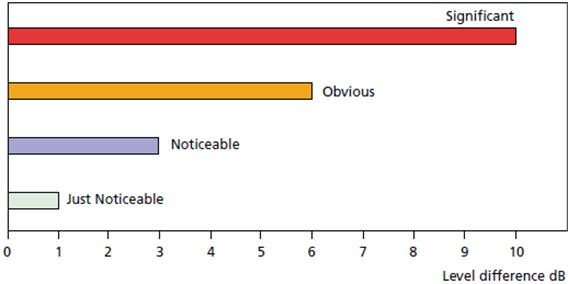
On the other hand the increase of sound level during damage process causes increase of the vehicles noise considered as line source. Road traffic is the most widespread source of noise in all countries and the most prevalent cause of annoyance and interference. Therefore, traffic noise reduction measures have the highest priority. Road traffic noise accounts for more than 90 % of unacceptable noise levels in Europe. From many methods for reduction of road noise, as thin noise-reduced surfaces or noise barriers, the acoustics monitoring of vehicle condition can be considered as extra alternative method.
2. Research method
For the noise measurement the sound level meters can be used. It is common practice to calibrate sound level meters using an acoustical calibrator before and after each series of measurements. Calibration is to check the instrument’s sensitivity at one specific frequency and sound level (usually 1 kHz and 94 dB). During the experiments the sound level meters SON-50 from SONOPAN company were used.
Fig. 2Scheme of the test stand and localization of points of the measurement surface: a) 1 – vehicle during research, 2 – test stand, 3 – sound level meter; b) 1-5 – measurement points
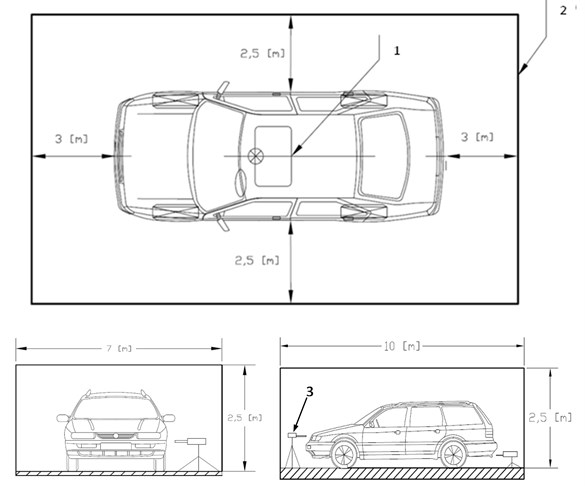
a)
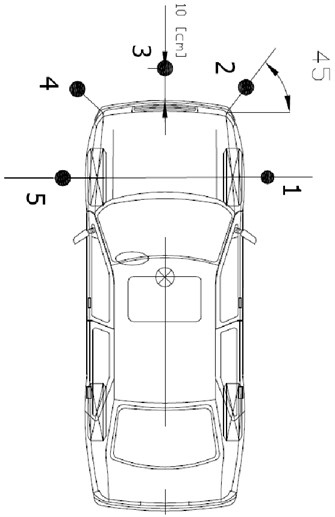
b)
For the purpose of the analysis of acoustics phenomena the broadband measurements, i. e., measurements covering the whole of the audible frequency range, were made using the “A” frequency weighting. Noise with distinct tones, for example, noise from fans, compressors is generally far more annoying than other types of noise. Spectral analysis may be needed for analysis of the dynamics of the noises. During the research the octave filter OF-50 has been used.
The scope of the research included measurements of the acoustics properties of the vehicles with the damages of the engine. Sound levels have been registered on the measurement surface in the laboratory with the special position for noise measurement. It is very important to create enough free space around the researched vehicle and to maintain the same measurement surface in each experiment.
To compare acoustics properties correlated with the damages the measurements were conducted before and after repair of the vehicle. Research set up allows maintaining the same measurement points and conditions for every research step. The test stand and localization of points of the measurement surface have been depicted in Fig. 2.
All experimental tests were conducted with the same conditions. The vehicle was standing and the engine was working with the idle gear rotational speed of 600 rpm, the temperature of the engine was set on ca. 70 ºC. In the laboratory all windows were closed and all different noise sources were closed.
Fig. 3View of the measurement and the research on the passenger car
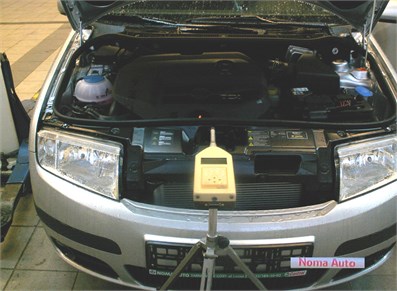
a)
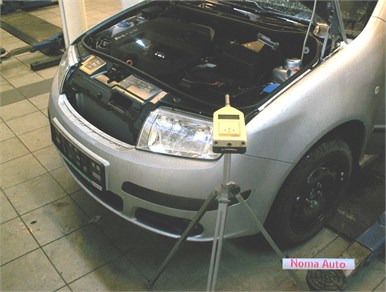
b)
3. Research results
The “equivalent continuous sound level”, the , is known across the globe as the essential averaged parameter. The is the level that, had it been a steady level during the measurement period, would represent the amount of energy present in the measured, fluctuating sound pressure level. The is measured directly with an integrating sound level meter. is a measure of the averaged energy in a varying sound level.
To complete analysis more estimators of sound level were recorded. For example – maximum A-weighted noise level measured with Slow (S) time weighting. It is the highest level of noise occurring during the measurement time. It is often used in conjunction with another noise parameter (e. g., ) to ensure a single noise event does not exceed a limit. It is essential to specify the time weighting (F, S or I). Another estimator is – minimum A-weighted noise level measured Slow (S) time weighting. It is the lowest level of noise occurring during the measurement time. Interpretation of sound level estimators has been depicted in the Figure 4.
Before each test the sound level in the laboratory has been measured. Those results were compared to sound level in the laboratory during test, when the engine of the vehicle was working. For each test the differences were more than 10 dB, so no corrections were needed.
The paper presents some chosen results of the investigation on vehicle with damages of the water pump and timing belt. The sound levels were measured before and after repair.
Fig. 4Interpretation of some sound level estimators
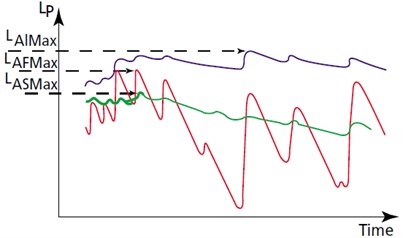
a)

b)
Fig. 5Global estimators of sound level
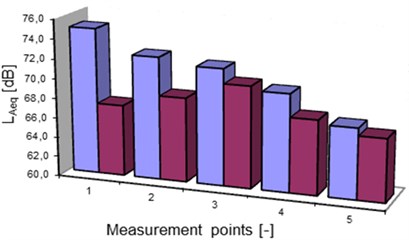
a)
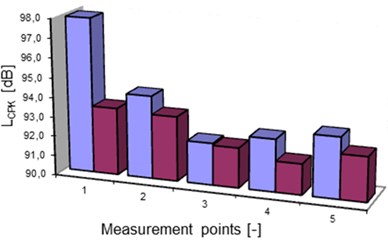
b)
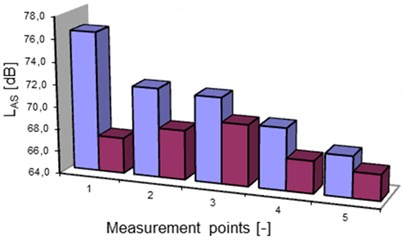
c)
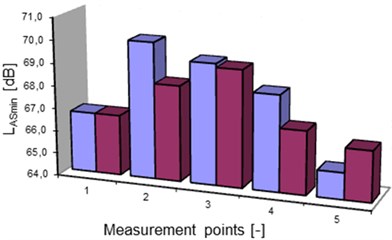
d)
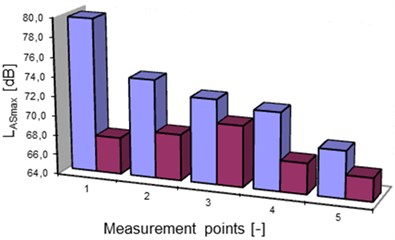
e)
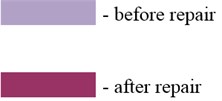
Fig. 6Octave analysis of sound level
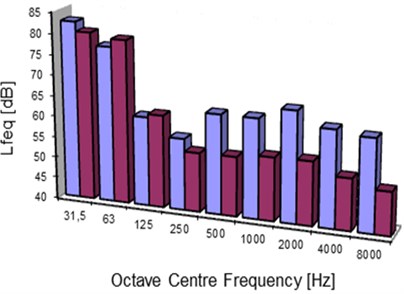
a) measurement point No. 1
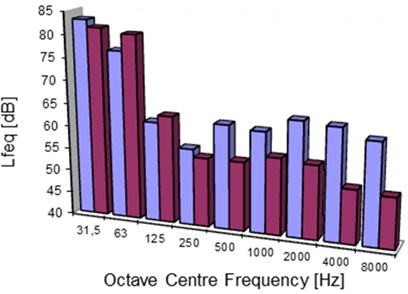
b) measurement point No. 2
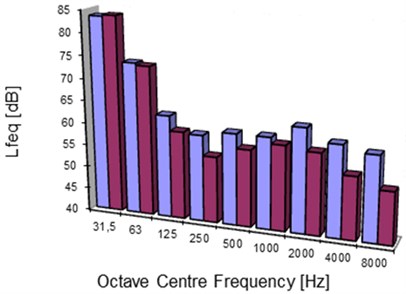
c) measurement point No. 3
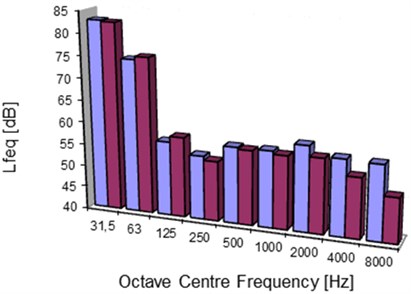
d) measurement point No. 4
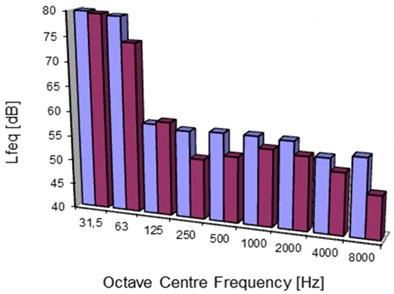
e) measurement point No. 5
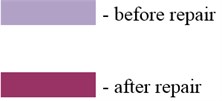
3.1. Global estimators of the sound level
During the first step of investigation the global estimators of the sound level were measured, such as:
- equivalent continuous A-weighted noise sound level,
- peak value C-weighted noise sound level,
- A-weighted noise level measured with Slow (S) time weighting,
- minimum A-weighted noise level measured with Slow (S) time weighting,
- maximum A-weighted noise level measured with Slow (S) time weighting.
The distribution of those estimators in measurement points before and after repair has been depicted in Fig. 5.
3.2. Frequency analysis of sound level
To evaluate and compare dynamics of the acoustics phenomena the octave spectrums were determined. It can be very helpful for recognition of dominant dynamics components of sound level as the symptom of the damages.
Knowledge of frequency bands can be used for calculation of dynamics (for example rotational speed) of the most dominant noise sources.
4. Conclusions
Analysis of the results shows that sound level generated by the engine contains mostly the low frequency components (octave bands centre frequencies 31.5 and 63). In all researched objects the sound level is higher where engine has some damages. After repair the level becomes lower.
The registered noise is depending on measurement point localization. For the measurement point no. 1 the sound level is highest, and the decrease of the noise is most significant in this point. The bigest changes of the noise level after and before repair can be observed for frequency band from 1000 Hz to 8000 Hz.
Acoustics phenomenas for working machines are very complicated. It has to be taken into consideration that there are many of influences in order to evaluate some diagnostics measures. The presented research is preliminary and the results allow to evaluate just in the quality aspect. For the quantitative assessment there has to be done many more research.
References
-
Bubulis A., Reizina G., Korobko E., Bilyk V., Efremov V. Controllable vibro-protective system for the driver seat of a multi-axis vehicle. Journal of Vibroengineering, Vol. 13, Issue 3, 2011, p. 552-557.
-
Burdzik R., Konieczny Ł. Research into noise emissions by a car combustion engine exhaust system. Scientific Papers of AMW, Vol. 52, Issue 1, 2011, p. 7-12.
-
Dąbrowski Z., Dziurdź J., Klekot G. Studies on propagation of vibroacoustic energy and its influence on structure vibration in a large-size object. Archives of Acoustics, Vol. 32, Issue 2, 2007, p. 231-240.
-
Burdzik R. Material vibration propagation in floor pan. Archives of Materials Science and Engineering, Vol. 59, Issue 1, 2013, p. 22-27.
-
Burdzik R. Monitoring system of vibration propagation in vehicles and method of analysing vibration modes. TST 2012, CCIS 329, Springer, Heidelberg, 2012, p. 406-413.
-
Figlus T., Wilk A., Łazarz B. Supporting of diagnosis of combustion engine condition on the basis of noise signal analysis. CDMTUR 2012, Žilina - Straža, Slovakia, 2012.
-
Dziurdź J. Transformation of nonstationary signals into pseudostationary signals for the needs of vehicle diagnostics. Acta Physica Polonica A, Vol. 118, Issue 1, 2010, p. 49-53.
-
Michalski R., Wierzbicki S. An analysis of degradation of vehicles in operation. Maintenance and Reliability, Vol. 1, Issue 3, 2008, p. 30-32.
-
Mencik J. Determination of parameters of visco-elastic materials by instrumented indentation. Part 3: Rheological model and other characteristics. Chem. Listy, Vol. 104, 2010, p. 275-278.
-
Environmental Noise. Brüel&Kjær Sound & Vibration Measurement A/S, Denmark, Naerum, 2001.
